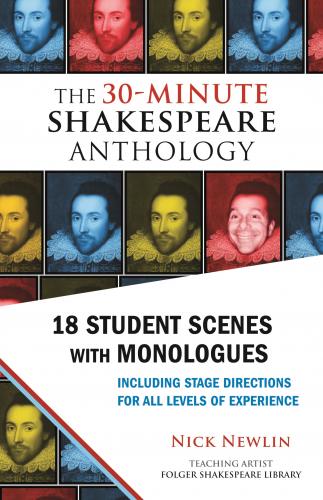You will enrich your understanding of the speech by exploring it within the scene, experiencing how others in the drama affect your role. Nobody lives in a vacuum. Shakespeare’s characters exist in relation to each other. Even if you do not perform the scene with other actors, I suggest that in addition to delving into that particular scene, you read, or preferably watch (or act), the whole play. This will allow you to become even more familiar with your part and deliver your speech with awareness and authority. I’ve included recommended videos of great performances for each monologue in this collection.
I list the scenes and monologues here by play, scene, number and gender breakdown of actors, monologue character, monologue gender, theme, and number of lines in the speech. Most monologues are one to two minutes long, and the scenes average about five minutes. Three of the scenes (Love’s Labor’s Lost, The Merchant of Venice, and The Tempest) are between eight and ten minutes in length. Even the shorter speeches are so rich in linguistic beauty and dramatic power that the work you do in bringing them alive will be time well spent.
SCENES AND MONOLOGUES AT A GLANCE
All scenes approximately five minutes in length unless otherwise specified. All monologues approximately 1–2 minutes in length.
AS YOU LIKE IT: ACT II, SCENES I AND VII
Four male characters; possible narrator and non-speaking roles
MONOLOGUE CHARACTER: Duke Senior, male
MONOLOGUE THEME: the uses of adversity
17 lines
THE COMEDY OF ERRORS: ACT II, SCENE II
Two female characters and two male characters; possible narrator
MONOLOGUE CHARACTER: Adriana, female
MONOLOGUE THEME: the inseparability of lovers and the contagion of adultery
37 lines
HAMLET: ACT III, SCENE I
One male character and one female character; possible narrator
MONOLOGUE CHARACTER: Ophelia, female
MONOLOGUE THEME: “a noble mind o’erthrown”
12 lines
HENRY IV, PART 1: ACT III, SCENE II
Two male characters; possible narrator
MONOLOGUE CHARACTER: Prince Henry, male
MONOLOGUE THEME: duty and redemption
22 lines
JULIUS CAESAR: ACT II, SCENE I
Four male characters and one female character; possible narrator and non-speaking roles
MONOLOGUE CHARACTER: Portia, female
MONOLOGUE THEME: sharing secrets with your spouse
26 lines
KING LEAR: ACT III, SCENE IV
Five male characters; possible narrator
MONOLOGUE CHARACTER: King Lear, male
MONOLOGUE THEME: physical and mental tempests
18 lines
LOVE’S LABOR’S LOST: ACT V, SCENE II
SCENE LENGTH: 8-10 minutes
Four female characters, and five male characters; possible narrator
MONOLOGUE CHARACTER: Princess, female
MONOLOGUE THEME: austerity and patience for love
25 lines
MACBETH: ACT I, SCENE V; ACT II, SCENES I AND II
One male character and one female character; possible narrator
MONOLOGUE CHARACTER: Lady Macbeth, female
MONOLOGUE THEME: ambition
16 lines
THE MERCHANT OF VENICE: ACT IV, SCENE I
SCENE LENGTH: 8-10 minutes
Five male characters and two female characters (disguised as men); possible narrator and non-speaking roles
MONOLOGUE CHARACTER: Portia, female (disguised as Balthazar, male)
MONOLOGUE THEME: “the quality of mercy”
23 lines
THE MERRY WIVES OF WINDSOR: ACT V, SCENE V
Six male actors and three female actors; possible narrator and non-speaking roles
MONOLOGUE CHARACTER: Falstaff, male
MONOLOGUE THEME: “love, which makes a beast a man, and a man a beast”
16 lines
A MIDSUMMER NIGHT’S DREAM: ACT IV, SCENE I
Six male characters and four female characters; possible narrator
MONOLOGUE CHARACTER: Oberon, male
MONOLOGUE THEME: retracting cruelty for love’s sake
30 lines
MUCH ADO ABOUT NOTHING: ACT II, SCENE III
Four male characters; possible narrator
MONOLOGUE CHARACTER: Benedick, male
MONOLOGUE THEME: giving up the argument against love
27 lines
OTHELLO: ACT II, SCENE III
Four male characters; possible narrator and non-speaking roles
MONOLOGUE CHARACTER: Iago, male
MONOLOGUE THEME: making evil out of good
27 lines
ROMEO AND JULIET: ACT III, SCENE V
Two male characters and three female characters; possible narrator
MONOLOGUE CHARACTER: Nurse, female
MONOLOGUE THEME: settling for a practical husband
14 lines
THE TAMING OF THE SHREW: ACT V, SCENE II
Five male characters and three female characters; possible narrator and non-speaking roles
MONOLOGUE CHARACTER: Katherine, female
MONOLOGUE THEME: what a woman owes her husband
44 lines
THE TEMPEST: ACT V, SCENE I
SCENE LENGTH: 8-10 minutes
Nine male characters and two female characters; possible narrator and non-speaking
